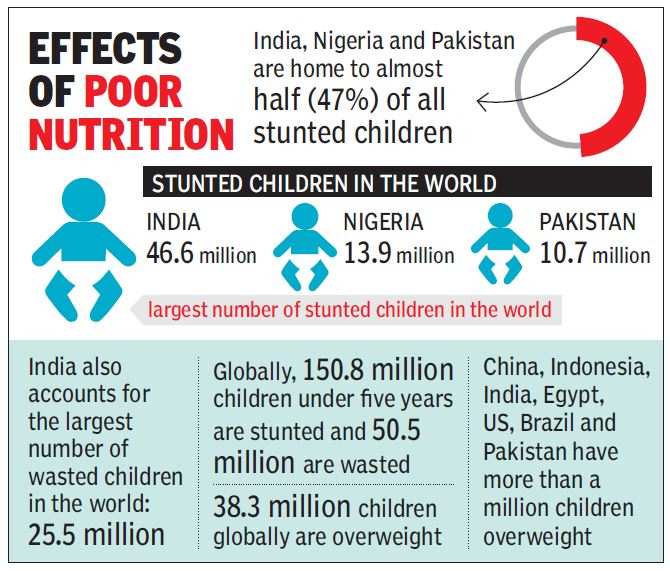ZERO HUNGER
Syllabus: GS Paper – II (Social Justice) – Issues relating to Poverty and Hunger.
State of Hunger in India
According to Food and Agriculture Organization of the United Nations (FAO) estimates in The State of Food Security and Nutrition in the World, 2020 report, 189.2 million people, that is 14% of the population, are undernourished in India.
Definitions
|
Global Hunger Index
- In the Global Hunger Index (GHI) Report, “hunger” refers to the index based on four component indicators. Taken together, the component indicators reflect deficiencies in calories as well as in micronutrients.
- Four component indicators are:
- Share of Undernourished Population
- Child Wasting: the share of children under the age of five who are wasted (CWA)
- Child Stunting: the share of children under the age of five who are stunted (CST)
- Child Mortality: the mortality rate of children under the age of five (CM)
- Index Values less than 10 reflect ‘low hunger’, values from 20 to 34.9 indicate ‘serious hunger’; values from 35 to 49.9 are ‘alarming’; and values of 50 or more are ‘extremely alarming’.

India’s Progress in GHI
- In the Global Hunger Index Report 2019, India was ranked at 102 out of 117 countries.
- In the Global Hunger Index Report 2020, India ranked 94 with a Global Hunger Index of 27.2.
- India has made considerable progress over the years which is evident from its GHI Scores – 48.1 in 1990 to 27.2 in 2020.

Steps Taken
- National Health Mission (NHM) includes programmatic components such as health system strengthening, Reproductive Maternal-Neonatal-Child and Adolescent Health (RMNCH A), and prevention and treatment of communicable and non-communicable.
- SDG India Index – The NITI Agog has brought out SDG India Index & Dashboard 2019-20 which measure the progress achieved and distance to be covered by the States/UTs in their journey towards meeting the targets, using the SDG India Index, covering 16 out of 17 SDGs.
- SDGs having a bearing on poverty, hunger and nutrition are: SDG 1. No Poverty SDG 2. Zero Hunger.
- To measure India’s performance towards the Goal of Zero Hunger, seven national-level indicators have been identified, which capture three out of the eight SDG targets for 2030 outlined under this Goal.
- In term of SDG Index Score for Goal 2, Goa and Chandigarh are the top-performing among States and UTs, respectively.
- Under the “Antyodaya Anna Yojana” (AAY), the poorest from amongst the BPL families are entitled to 35 kg of food grains per month at more subsidised rates.
- Under the Integrated Child Development Services children in the age range 6 months to 6 years, pregnant women and lactating mothers are provided access to nutritious food.
- Mid-day meal (MDM) aimed at achieving better nutrition standards for school going children.
- The National Nutrition Mission (Poshan Abhiyaan) to reduce stunting, under-nutrition, anaemia (among young children, women and adolescent girls), and low birth weight by 2 per cent, 2 per cent, 3 per cent, and 2 per cent per annum, respectively. It targets to bring down stunting among children in the age group 0-6 years from 38.4 per cent to 25 per cent by 2022.
- Strategy for doubling farmers’ income focuses on seven growth factors: improved crop productivity, increased livestock productivity, cost-effective production processes, increased cropping intensity, crop diversification favouring high-value crops, access to better prices and shifting to the non-farm occupation.
- 221 million soil health cards have been distributed so far to farmers.
- The Pradhan Mantri Krishi Sinchayee Yojana (PMKSY) focuses on improved water efficiency with the motto of “Har Khet Ko Paani” and “Per drop more crop”.
- The Pradhan Mantri Fasal Bima Yojana (PMFBY) provides better insurance coverage and agricultural credit at a reduced rate of 4 per cent per annum to farmers.
- Minimum support prices for all kharif and rabi crops have been increased at least by 150 per cent of the cost of production.
- Pradhan Mantri Kisan Scheme has been initiated to extend the payment of INR 6,000 per year to every farmer in the country, which provides a further boost to their income.
- Under Pradhan Mantri Kisan Sampada Yojana, financing of mega food parks, infrastructure of agro-processing clusters, and integrated cold chain and value addition infrastructure are undertaken.

